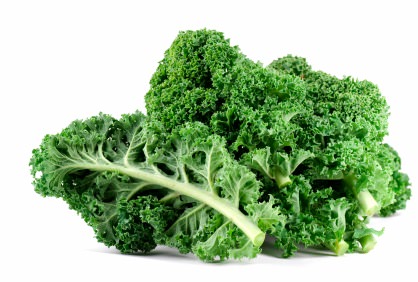Kale (pronounced “kayle”), also known as Borecole or BrassicaOleracea, is a green leafy vegetable. It is considered to be a wild cabbage, that comes in green or purple colored varieties.
Although available all through the year, kale is widely seen in the market from mid-winter until the spring ends. It is available as dinosaur kale, ornamental kale and curly kale in the market.
Kale’s powerhouse nutritional profile makes it a star in three particular areas:
1. Antioxidants
2. Anti-inflammatory nutrients
3. Anti-cancer nutrients
Kale: Vitamins, minerals and healthy chemicals galore!
– Kale is an excellent source of beta carotene (which converts to vitamin A in the liver), vitamin K, vitamin C, lutein and zeaxanthin.
– Kale contains glucosinolates and their derived Isothiocyantes such as: indole-3-carbinol, sulforaphane, phenethyl-isothiocyanate, benzyl-isothiocyanate and allyl-isothiocyanate (more on these later!).
– Kale also contains smaller amounts of omega-3, Riboflavin (B2), Niacin (B3), Thiamine (B1), Pantothenic acid (B5), Vitamin B6, Folate (B9), Vitamin E, Iron, Magnesium, Manganese, Phosphorus, Potassium and Zinc.
– It is also an especially noteworthy source of calcium!
Here is a quick look at what some of these specific nutrients do:
1. Antioxidants
Zeaxanthin and lutein (both carotenoids): Zeaxanthin and lutein are powerful antioxidants that protect against degenerative illnesses such as cancer, cardio-vascular disease and macular degeneration.
2. Anti-inflammatory
Vitamin K and Omega-3: Vitamin K and Omega-3 play key roles in reducing inflammation in the body by regulating the inflammatory processes.
3. Anti-Cancer
Glucosinolates: Kale, along with the rest of the members of the Brassica family (such as cabbage and broccoli), contains a number of these anti-cancer chemicals. These groups of glucosinolates and their derived isothiocyantes block the growth of certain types of cancer cells, boost DNA repair and help cells to detox!
Agencies/Canadajournal
 Canada Journal – News of the World Articles and videos to bring you the biggest Canadian news stories from across the country every day
Canada Journal – News of the World Articles and videos to bring you the biggest Canadian news stories from across the country every day



